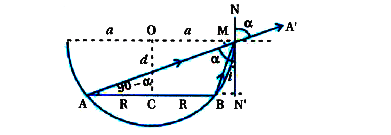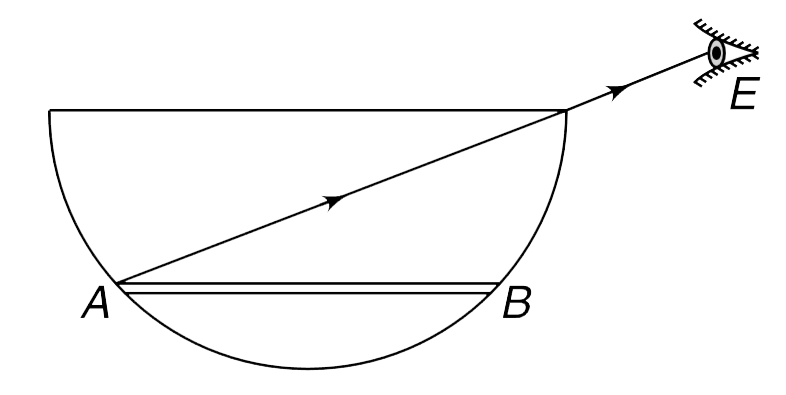A cicular disc of radius R is placed co-axially and horizontally inside an opaque hemi spherical bowl of radius .a. (see figure). The faredge of the disc in just visible when viewed from the edge of the bowl . The bowl is filled with transparent liquid of refractive index μ and the near edge of the disc becomes just visible. How far below the top of the bowl is the disc placed ?
 Solution in Gujrati
Solution in Gujrati
Consider situartion before pouring water in an opaque bowl of radius a. Now consider a circular disc of radius R and centre C which si placed inside the bowl horizontnally and coaxially with the bowl. Here we have to calculate OC=d .
⇒ Here before filling bowl with water, incident light ray is AMA. . Now when water is paured in the hemispherical bowl completely, the nearer and B of the disc is seen for which inciden ray is −−→BM and refracted ray is −−→MA. Here NN. is perpedicular to water surface, drawn at point M. Hence anl≥(BMN) = i (angle of incidence) and ∠NMA=α (angle of refraction)
⇒ Now, applying Snell.s law at point M ,
usini=(1)sinr
∴μsini=sinα(∴r=α)
∴1μ=sinisinα ........(1) [∵r=α]
Now, from , figure
sini=BN.BM
but BN.=CN.−CB=OM−CB
and BM=√d2+(a−R)2
∴sini=√a−R√d2+(a−R)2...... (2)
and sinα=cos(90∘−α)=AN.AM=AC+CN.AM
∴sinα=AC+OMAM
=a+R√d2(a+R)2........(3)
∴ From equation (1),(2) and (3),
1μ=a−R√d2+(a−R)2×√d2+(a+R)2a+R
∴μ(a−R)(√d2+(a+R)2)=(a+R)(√d2+(a−R)2)
Taking squares on the both sides,
∴μ2(a−R)2{d2+(a+R)2}=(a+R)2{d2+(a−R)2}
∴{μ2(a−R)2d2}+{μ2(a−R)2(a+R)2}={d2(a+R)2}+{(a+R)2(a−R)2}
∴(a−R)2(a+R)2(μ2−1)=d2{(a+R)2−μ2(a−R)2}
∴d2=(μ2−1){(a−R)(a+R)}2(a+R)2−μ2(a−R)2
∴d2=(μ2−1)(a2−R2)2(a+R)2−μ2(a−R)2
∴d=
⎷μ2−1(a+R)2−μ2(a−R)2×(a2×b2)
⇒ Above equation gives required result.
Topper's Solved these Questions
- RAY OPTICS AND OPTICAL INSTRUMENTSBOOK - KUMAR PRAKASHANCHAPTER - RAY OPTICS AND OPTICAL INSTRUMENTSEXERCISE - SECTION-C (NCERT EXEMPLAR SOLUTION) (LONG ANSWER TYPE QUESITONS)
5 Videos
- RAY OPTICS AND OPTICAL INSTRUMENTSBOOK - KUMAR PRAKASHANCHAPTER - RAY OPTICS AND OPTICAL INSTRUMENTSEXERCISE - SECTION-D (MULTIPLE CHOICE QUESTIONS (MCQs))(MCQs FROM .DARPAN. BASED ON TEXTBOOK)
26 Videos
- RAY OPTICS AND OPTICAL INSTRUMENTSBOOK - KUMAR PRAKASHANCHAPTER - RAY OPTICS AND OPTICAL INSTRUMENTSEXERCISE - SECTION-C (NCERT EXEMPLAR SOLUTION) (VERY SHORT ANSWER TYPE QUESITONS)
5 Videos
- MOVING CHARGES AND MAGNETISMBOOK - KUMAR PRAKASHANCHAPTER - MOVING CHARGES AND MAGNETISMEXERCISE - SECTION D (MCQs ASKED IN COMPETITIVE EXAMS)
34 Videos
- SAMPLE QUESTION PAPER BOOK - KUMAR PRAKASHANCHAPTER - SAMPLE QUESTION PAPER EXERCISE - PART-B SECTION-C
5 Videos
Similar Questions
Show that for a material with refractive index μ≥√2~ , light incident at any angle shall be guided along a length perpendicular to the incident face.
View SolutionDiameter of spherical mirror is 10 cm, what will be aperture of mirror ?
View SolutionWill the focal length of a lens for red light be more, sam or less than that for blue light
View SolutionElectric charge Q having mass M moves on a circular path of radius R with velocity →v, perpendicular to uniform magnetic field B. When a particle completes one revolution, work done by the field is _______
View SolutionTwo charges –q and +q are located at points (0, 0, –a) and (0, 0, a), respectively.
(a) What is the electrostatic potential at the points (0, 0, z) and (x, y, 0) ?
(b) Obtain the dependence of potential on the distance r of a point from the origin when r/a>>1 .
(c) How much work is done in moving a small test charge from the point (5,0,0) to (–7,0,0) along the x-axis? Does the answer change if the path of the test charge between the same points is not along the x-axis?
View SolutionA circular disc of radius 'R' is placed co-axially and horizontally inside and opaque hemispherical bowl of radius 'a', Fig. The far edge of the disc is just visible when viewed from the edge of the bowl. The bowl is filled with transparent liquid of refractive index mu and the near edge of the dise becomes just visible. How far below the top of the bowl is the disc placed ? .
View SolutionA stick is placed inside a hemispherical bowl as shown in Figure. The stick is horizontal and has a length of 2a. Eye of an observer is located at E such that it can just see the end A of the stick. A liquid is filled upto edge of the bowl and the end B of the stick becomes visible to the observer. Radius of the bowl is R. Find the refractive index (μ) of the liquid.

View SolutionA coin kept in a bowl is not visible when seen from one side. But, when water is poured in the bowl, the coin becomes visible.
View Solution9cm आतंरिक त्रिज्या वाले एक अर्द्धगोलिये कटोरा एक द्रव से भरा है इस द्रव को 3cm व्यास और 4cm उचाई वाले छोटे-छोटे बनाकर बोतलों में भरना है कटोरा को खली करने के लिए कितने कटोरो
View SolutionA coin kept in a bowl is not visible when seen from one side. But, when water is poured in the bowl, the coin becomes visible.
View Solutionद्रव्यमान m की एक वस्तु त्रिज्या R वाले अर्द्धगोलीय प्याले के धरातल पर इसके किनारे से नीचे की ओर सरकती है | प्याले की तली पर पहुँचने पर वस्तु का वेग होगा :
View SolutionA round pebble is released from the point X inside a frictionless hemispherical ball as shown in the figure such that it just upto edge Y of the bowl . With what speed the pebble is released down inside the bowl ?
View SolutionA spherical shaped fish bowl filled with water of refractive index 1.3 is placed in another large tank filled with another liquid of refractive index 1.4 such that rim of the fish bowl is slightly above the liquid filled in the tank. The diameter of the fish bowl is 20 cm. A parallel light rays from a distant object is incident on the spherical fish bowl. Find the position at which incident light rays will get focused when seen by a small fish at the centre of the bowl.
View SolutionA fish bowl of diameter 20 cm is filled with a liquid of refractive index 1.4. A letter O is written on the outer surface of the bowl. Determine the position of the image of the word formed when observed through the bowl from the opposite side.
View SolutionIf the coefficient of friction between the worm and the bowl mu If the radius of the bowl is r then the maximum height where the bugs can crawl into the bowl
View Solution
